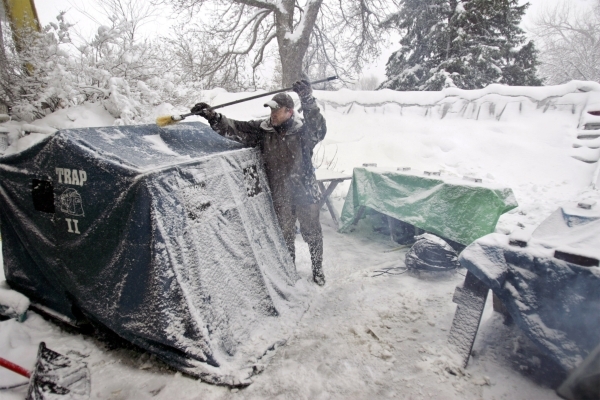Ice fishing can be found in Southwest, but be careful
In some parts of the country, ice fishing is serious business, an outdoor pursuit undertaken with an almost religious fervor. Those of you who hail from the upper Midwest know what I am talking about and probably can trace the ice fishing gene back through your genealogy.
While fishing Minnesota's Lake of the Woods a few springs ago, I learned just how serious ice fishing can be. Though the ice and freezing temperatures were long gone when I arrived, the manager of the lodge where I stayed told me about life on the lake during ice fishing season. He told me about roadways on the ice that come complete with semitrucks and stop signs. He also talked about small communities of ice houses that pop up each winter at locations scattered across the large lake.
Ice houses, he explained, are just that. Houses built on skids that are pulled onto the ice with a track driven snow machine. Some are for day use, while others include sleeping areas and cooking facilities for multiple-day stays on the ice. Some have more than one story, he said. To which I replied: "Yeah, I don't think so!"
Somehow the thought of sleeping overnight on a slab of ice was more than a little disconcerting, and I said as much. He just laughed and attributed my lack of ice trust to my western roots. No doubt he was right. Thoughts of driving my pickup onto an ice-covered lake include visions of my truck sinking out of sight.
It is not that we don't have ice fishing opportunities in the Southwest. We do. Just not to the extent you will find in those parts of the country where water and subfreezing temperatures are as common to local residents as creosote bushes and 100-degree days are for us.
If you are thinking about trying ice fishing this winter, you might want to include the following destinations on your list. All are less than a four-hour drive from Las Vegas.
Eagle Valley Reservoir and Echo Canyon Reservoir are located a few miles east of Pioche in Lincoln County. Both can be accessed via paved roads from Highway 93 and offer year-round camping facilities, though for obvious reasons amenities that require water are unavailable during the winter. While both reservoirs hold warm water species such as largemouth bass, ice fishing activity generally targets trout. Species include rainbow, brown and tiger trout.
Farther to the west and about 70 miles north of Alamo along Highway 318, you will find the Kirch Wildlife Management Area, home to four reservoirs that hold largemouth bass, crappie and rainbow trout. Those waters include Haymeadow, Cold Springs, Adams-McGill and Dacey reservoirs.
Haymeadow and Cold Springs are perhaps the most popular for ice fishing. Known to old-timers as Sunnyside, Kirch offers a limited ice-fishing season because it is generally one of the last locations where ice forms and the first to thaw in the spring. The earliest I have fly-fished at Kirch is mid-February. Camping facilities are primitive.
Going northeast into Utah, a primary ice-fishing destination is Panguitch Lake. This popular summer trout fishery also provides excellent ice fishing. Depending on road conditions, you may have to be a little creative in your trip planning, but it is generally accessible. Other waters on Cedar Mountain include Duck Creek Pond and Aspen Mirror Lake. Near the town of Beaver, you will find ice-fishing opportunities at Minersville Reservoir and at the lakes on Beaver Mountain.
Starting with the ice itself, safety is always a primary concern when on an ice-fishing adventure. Always check ice conditions before you leave home, but be prepared to do some homework because that information may not be available with a single mouse click or phone call.
Along with official channels, check with local bait shops, sporting goods stores, gas stations and even lodges that depend on angler traffic for income. They generally will have current information. Then verify the ice thickness yourself before venturing onto the ice.
Keep in mind that some waters, like those at the Kirch WMA, are fed at least in part by water from warm springs. Warm water can weaken ice from the underside.
If the ice is 2 inches thick or less, stay off the ice. It is simply too thin for an angler to walk on, let alone more than one. If it is 4 to 5 inches thick, the ice should support an angler on foot. I prefer to see it closer to 8 inches thick or more.
Lastly, never go ice fishing alone. Always take a partner who can provide help or call for help if necessary.
Freelance writer Doug Nielsen is a conservation educator for the Nevada Department of Wildlife. His "In the Outdoors" column, published Thursday in the Las Vegas Review-Journal, is not affiliated with or endorsed by the NDOW. Any opinions he states in his column are his own. He can be reached at intheoutdoorslv@gmail.com.







